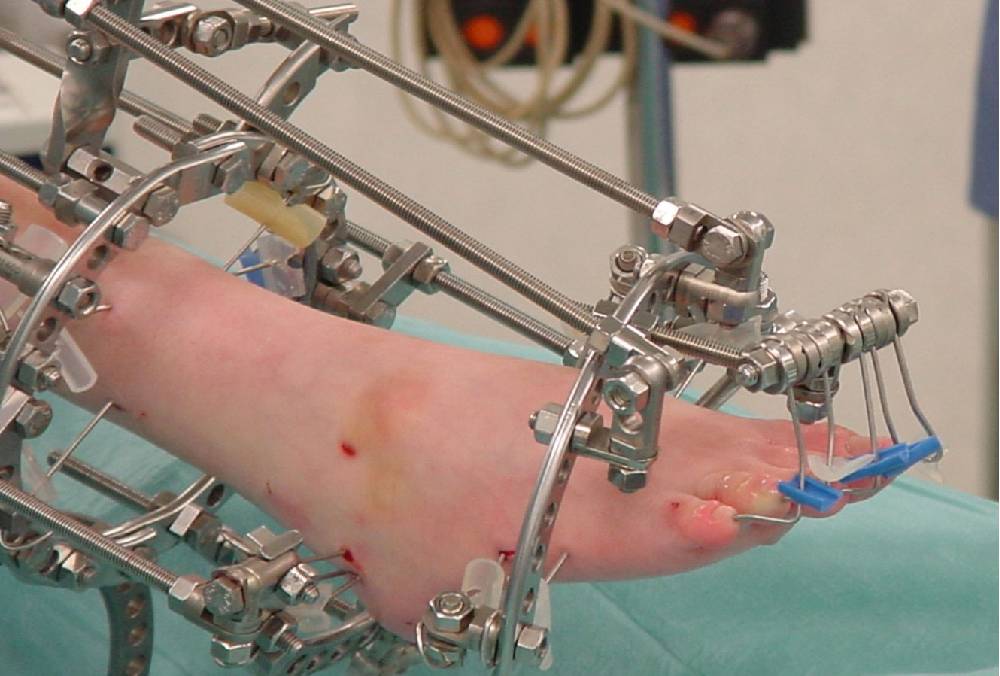Ilizarov Surgery

What is Ilizarov Surgery?
Ilizarov surgery is a specialized orthopedic technique used to treat complex bone fractures, deformities, and length discrepancies. It involves the use of an external device called the Ilizarov apparatus, which is a frame made of metal rings, rods, and wires that are attached to the affected limb. This apparatus is used to stabilize the bones and, in certain cases, gradually lengthen them through a process known as distraction osteogenesis.
The procedure was developed by Russian orthopedic surgeon Gavriil Ilizarov in the 1950s and has since become a widely accepted method for correcting bone deformities, lengthening limbs, and healing fractures that do not respond to traditional treatments. Ilizarov surgery is particularly useful in cases where other surgical methods may not be effective, such as in severe fractures, congenital deformities, or limb length discrepancies.
The procedure was developed by Russian orthopedic surgeon Gavriil Ilizarov in the 1950s and has since become a widely accepted method for correcting bone deformities, lengthening limbs, and healing fractures that do not respond to traditional treatments. Ilizarov surgery is particularly useful in cases where other surgical methods may not be effective, such as in severe fractures, congenital deformities, or limb length discrepancies.
Causes :
Ilizarov surgery is often recommended when other conventional treatments (such as casting, internal fixation, or braces) have not been successful or are not viable. Some common causes for requiring Ilizarov surgery include:
- Complex or Non-Union Fractures: When a bone fracture fails to heal properly or becomes a non-union, the Ilizarov technique can stabilize the bone and promote healing.
- Bone Length Discrepancies: Differences in limb length, whether congenital (present at birth) or acquired (due to injury or disease), can be corrected by using the Ilizarov apparatus to lengthen bones gradually.
- Bone Deformities: Conditions like congenital deformities, post-traumatic deformities, or deformities caused by diseases like rickets or osteogenesis imperfecta can be corrected by the Ilizarov method, realigning the bone structure for proper function.
- Post-Traumatic Limb Deformities: Severe deformities resulting from trauma or previous surgical complications may require Ilizarov surgery to correct the alignment and improve functionality.
- Infected Fractures: For fractures that have become infected and have not healed well, the Ilizarov method can help stabilize the bone while treating the infection and promoting healing.
- Limb Lengthening for Cosmetic or Functional Purposes: In some cases, individuals may seek Ilizarov surgery for elective limb lengthening to address leg length discrepancies or for aesthetic reasons.
Symptoms :
Ilizarov surgery may be needed if you experience any of the following symptoms that significantly affect your mobility, bone function, or quality of life:
- Chronic Pain or Discomfort: Persistent pain in the limb due to non-healing fractures, bone deformities, or misalignments may require surgical intervention.
- Immobility or Limited Movement: Difficulty moving the affected limb, whether from bone deformities, fractures, or misalignment, can be corrected with Ilizarov surgery.
- Uneven Limb Length: A noticeable difference in the length of your arms or legs that causes difficulty with walking, running, or performing everyday tasks may be addressed with this procedure.
- Visible Deformities: Abnormal bone structures, such as crooked bones or angular deformities, that cause functional limitations can benefit from the precision of the Ilizarov method.
- Non-Union Fractures: When a fracture fails to heal properly despite initial treatment, surgery may be required to re-stabilize the bone and promote healing.
- Inability to Perform Daily Activities: If you find that fractures, deformities, or limb discrepancies prevent you from carrying out daily activities such as walking, driving, or exercising, Ilizarov surgery may restore your ability to function normally.
The Approach to Ilizarov Surgery
Ilizarov surgery is a highly precise and methodical procedure, requiring careful planning and execution. The general approach involves the following steps:
- Pre-Surgical Assessment: Prior to the surgery, a detailed evaluation is conducted. This includes medical history review, physical examinations, and imaging tests (like X-rays, CT scans, or MRI) to understand the extent of the problem and plan the surgery accordingly.
- Osteotomy (Bone Cutting): If necessary, the surgeon will perform an osteotomy (cutting of the bone) to realign or lengthen the bones. This step is crucial for addressing deformities or correcting limb length discrepancies.
- Application of the Ilizarov Apparatus: After the bone is prepared, the Ilizarov apparatus (an external fixation frame) is attached to the limb. The apparatus consists of metal rings that are connected to the bone using wires or pins. These rings allow the surgeon to control the position of the bones and, in the case of lengthening, to gradually increase the distance between the bone segments.
- Gradual Lengthening or Realignment: If the procedure involves lengthening, the Ilizarov frame will be adjusted incrementally—usually by 1 millimeter per day. This gradual adjustment allows the bone to lengthen and new bone tissue to form in the gap, a process known as distraction osteogenesis. The external fixator can also be adjusted to correct angular deformities by gradually shifting the bones into proper alignment.
- Bone Healing and Consolidation: Over time, the bone will heal and consolidate in its new position or length. This process typically takes several months, during which the Ilizarov apparatus is carefully monitored and adjusted. The frame may be used for several months to ensure proper bone healing.
- Post-Surgical Recovery: After the desired alignment or lengthening is achieved, the Ilizarov apparatus will remain in place until the bone is fully healed. Rehabilitation is an essential part of recovery, which may include physical therapy to restore strength, flexibility, and function.
Our Process for Ilizarov Surgery Treatment
At our Hospital, we take a comprehensive and patient-centered approach to Ilizarov surgery, ensuring that each patient receives the best possible care throughout their treatment journey. Our process involves:
- Initial Consultation: The first step is a thorough consultation with our orthopedic specialists. We will assess your medical history, symptoms, and review your imaging results to determine if Ilizarov surgery is the most appropriate treatment for your condition.
- Customized Treatment Plan: Based on your diagnosis, we will develop a personalized treatment plan. This plan will outline the specific steps of the Ilizarov procedure, including the type of adjustments required (such as lengthening or deformity correction), as well as a detailed post-surgical care plan.
- Pre-Operative Preparations: Our team will provide you with all the necessary information and instructions for preparing for surgery. This may include stopping certain medications, fasting before the procedure, and arranging for post-surgical care and rehabilitation.
- Surgical Procedure: On the day of surgery, our expert orthopedic surgeons will carefully perform the procedure, using advanced techniques to apply the Ilizarov apparatus, make any necessary bone adjustments, and begin the healing process.
- Post-Surgery Care and Monitoring: After surgery, you will be closely monitored as the bone heals. We will provide regular follow-up appointments to adjust the Ilizarov apparatus as needed and to ensure the bone is healing properly.
- Rehabilitation: Once the healing process is underway, we will guide you through rehabilitation to restore movement, strength, and functionality in the affected limb. Our rehabilitation programs are tailored to your specific needs and may include physical therapy and exercises to help you regain full use of the limb.
- Ongoing Support and Long-Term Care: Our commitment to your recovery doesn’t end after the surgery. We will continue to provide follow-up care, monitoring your progress and ensuring that your bone heals correctly, while addressing any concerns or complications that may arise during recovery.
